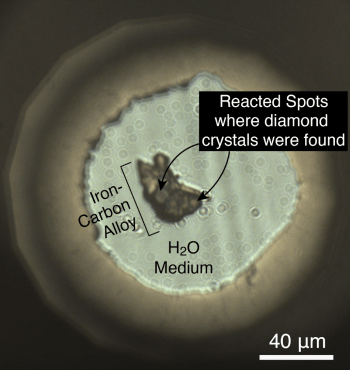
TEMPE, Ariz. — A layer of diamonds may be sitting near the Earth’s core, according to a new study. Scientists at Arizona State University say the heat and pressure at the planet’s core-mantle boundary could be creating an amazing fortune in diamonds deep below the surface.
The study explains that one thing geologists are sure to find near the core is rust. On the surface, steel rusts with exposure to air and water.
At the Earth’s core, the oceanic crust which sits on top of tectonic plates falls into the interior in a process called subduction. This crust contains hydrous minerals that sometimes makes it all the way to the core-mantle boundary.
Study authors note that the temperature at this layer is more than twice as hot as lava — making it hot enough for the hydrous minerals to release water. When that occurs, a chemical reaction takes place similar to steel rusting on the surface.
ASU PhD graduate Byeongkwan Ko and his team have been simulating this reaction in their lab by compressing iron-carbon alloy and water together under conditions scientists would expect to see at the core-mantle boundary. Their results reveal that water and metal form iron oxides and iron hydroxides — just like rusting metal does on the surface. That’s not all, however, as carbon coming out of the melting iron metal alloy turns into diamonds!
“Temperature at the boundary between the silicate mantle and the metallic core at 3,000 km depth reaches to (about 7,000 degrees Fahrenheit), which is sufficiently high for most minerals to lose H2O captured in their atomic-scale structures,” says Dan Shim, a professor at ASU’s School of Earth and Space Exploration, in a university release. “In fact, the temperature is high enough that some minerals should melt at such conditions.”
The core is the largest carbon storage on Earth
Since carbon is an iron-loving element, scientists believe there’s a large amount of carbon in the Earth’s core. Researchers note that roughly 90 percent of the planet’s carbon may sit down there. On the other hand, studies have suggested that there’s relatively low amounts of carbon in the mantle.
However, scientists have recently found much more carbon in the mantle than they expected.
“At the pressures expected for the Earth’s core-mantle boundary, hydrogen alloying with iron metal liquid appears to reduce solubility of other light elements in the core. Therefore, solubility of carbon, which likely exists in the Earth’s core, decreases locally where hydrogen enters into the core from the mantle (through dehydration),” Shim says. “The stable form of carbon at the pressure-temperature conditions of the Earth’s core-mantle boundary is diamond. So the carbon escaping from the liquid outer core would become diamond when it enters into the mantle.”
“Carbon is an essential element for life and plays an important role in many geological processes. The new discovery of a carbon transfer mechanism from the core to the mantle will shed light on the understanding of the carbon cycle in the Earth’s deep interior,” Ko adds. “This is even more exciting given that the diamond formation at the core-mantle boundary might have been going on for billions of years since the initiation of subduction on the planet.”

Can scientists detect mountains of diamonds inside the Earth?
The study reveals that carbon leaking from the core into the mantle through this diamond-making process may explain why scientists are now finding more carbon in the planet’s mantle. The team believes that large structures of diamonds can safely exist in the core-mantle boundary. Moreover, seismic studies should be able to detect them because seismic waves should travel differently through these structures than regular rock.
“The reason that seismic waves should propagate exceptionally fast through diamond-rich structures at the core-mantle boundary is because diamond is extremely incompressible and less dense than other materials at the core-mantle boundary,” Shim explains.
The findings are published in the journal Geophysical Research Letters.

